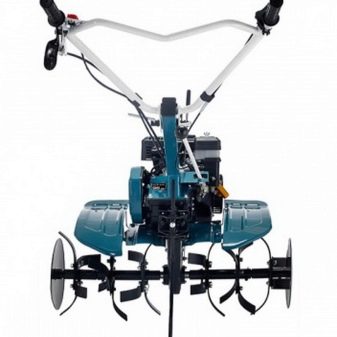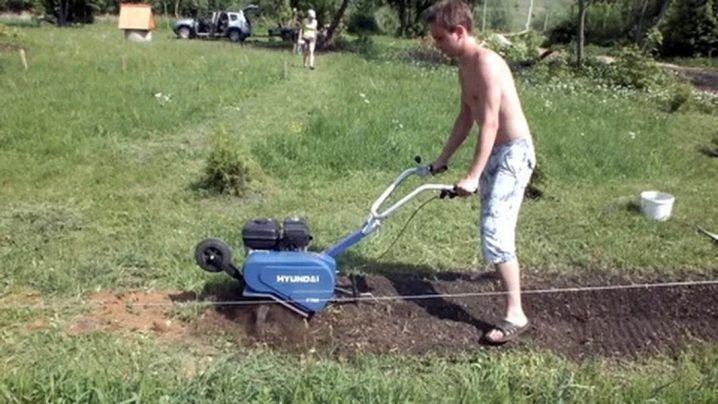Hyundai motoblocks: varieties and operating instructions

Hyundai motoblocks are quite popular and reliable devices. In the article we will consider the types and models of devices, study the technical characteristics and features, and also get acquainted with the rules of operation.

What it is?
A walk-behind tractor is a mobile vehicle based on a single-axle chassis. Hyundai motoblocks are motoblocks with gasoline engines with a capacity of 3.5 to 7 liters. with. With the help of the device, various working elements are set in motion, which, in turn, are used in the cultivation of the soil on the sites.
The walk-behind tractor can be operated in areas with a mild climate.
The use of a walk-behind tractor as a loosening agent will be advisable at ambient temperatures in the range from +1 to +40 degrees.
If you follow the rules of operation, maintenance and storage, which are indicated in the instructions (supplied with the walk-behind tractor), the service life of the unit will be quite long.

Types and models
The classification of walk-behind tractors includes several types of devices.

Light motoblocks
Equipped with four-stroke engines from 2.5 to 4.5 liters. s, have a weight within 80 kg, the width of the treated surface is up to 90 cm, the depth of processing is 20 cm.


Medium motoblocks
Supplied with engines up to 7 HP. with. and weighing no more than 100 kg. Equipped with a transmission with one or two forward speeds and one reversible. They combine the properties of a station wagon, due to this, various additional devices can be connected to them.


Heavy motoblocks
Engines with powers up to 16 liters are obtained. with. and weighing from 100 kg. They are used mainly on a large scale, for example, for farming purposes. There are many alternative attachments available for these machines.

At the moment, the lineup of motoblocks from the Hyundai company includes many models. Let's consider the most popular ones.
- Hyundai T500 - the smallest of the presented petrol models. This model is equipped with a 3.5 liter Hyundai IC90 gasoline engine. with. With the help of a chain reducer, the service life of this walk-behind tractor is increased. This unit weighs only 30 kg. No reverse gear.

- Hyundai T700... This model is perfect for rural residents with a plot of up to 20 acres. This unit is equipped with a 5.5 liter Hyundai IC160 petrol engine. with. The cutting width of the cutters varies between 30-60 cm. The weight of such a unit is 43 kg. This unit has only 1 gear, which moves forward.

- Hyundai T800 - a copy of the T700 model, but the unit has a reverse gear. The working area for this device is within 30 acres. The device weighs 45 kg.


- Hyundai T850 is equipped with a 6.5 liter Hyundai IC200 petrol engine. with. Has a recoil starter to start the engine. The cultivation width of this walk-behind tractor is adjustable in 3 positions: 300, 600 and 900 mm. Thanks to the improved chain reducer, the service life of this unit is increased. The T850 model is equipped with two gears: one forward and one reverse.

- Hyundai T1200 - the most powerful model of the entire line of motoblocks. Equipped with 7 HP Hyundai IC220 petrol engine. with. To prevent the engine from falling out during operation, a sturdy metal frame was used for fastening.The cutting width is adjustable in 3 positions 300, 600 and 900 mm. This unit has the greatest cultivation depth, which is 32 cm. The manufacturer gives a guarantee for this model - it will work flawlessly for 2000 hours.

Specifications
Technical characteristics of Hyundai motoblocks:
- engine model - Hyundai IC90, IC160, IC200, IC220;
- engine type - gasoline, 4-stroke;
- power - from 3.5 to 7 liters. with;
- the width of the cultivated soil - from 30 to 95 cm;
- the depth of the cultivated soil - up to 32 cm;
- unit weight - from 30 to 65 kg;
- transmission - chain reducer;


- belt clutch;
- number of gears - 1 or 2 (depending on the model);
- the recommended type of oil for the engine is SAE-10 W30;
- number of cutters - up to 6 pieces;
- cutter diameter - up to 32 cm;
- fuel tank volume - up to 3 liters;
- maximum speed - up to 15 km / h.

Accessories and attachments
Hyundai tillers can be equipped with a wide range of attachments.
- Cutters - such equipment comes with most of the models and is used for loosening and cultivating the soil. With its help, the upper soil layer is mixed, the yield is improved.
- Plow it is necessary in order not to damage the cutters when working with stony soil. Plows are most often used to cultivate virgin soil. The company offers several variations of plows to choose from: open-planer plow and double-turn plow. They have such a design, with the help of which they break up the formed blocks of earth.
- Mower - the necessary device to solve the problem with lush growing grass. The manufacturer makes it possible, when buying a walk-behind tractor, complete with a unit, to purchase rotary mowers. Due to the fact that the knives are made of hardened steel, they do not break off when struck by roots, stones or hard soil.
- Potato diggers and potato planters... Hyundai tillers have the ability to plant and dig out potatoes, which is simply an indispensable function for farmers.


- Also, Hyundai walk-behind tractors can be used as snow blowers... With their help, the removed layer of snow can be thrown at a distance of up to 15 meters (the distance of throwing snow depends on the power of the walk-behind tractor). In winter, you can "change" your Hyundai walk-behind tractor into tracks. Due to the fact that they have an increased contact area with the surface, the walk-behind tractor can move on snow or ice without any problems.
- If it is necessary to transport cargo over a long distance, Hyundai has on sale trailers with a special seat for the operator.
- For smooth movement on roads or land, walk-behind tractors are equipped with pneumatic wheels... In the event that these wheels are not enough, you can purchase lugs, which move with the help of metal plates on viscous soil.
- If it is not possible to purchase tracks or lugs, the manufacturer also offers weighting agents, with which you can increase the weight of the walk-behind tractor and its adhesion to the surface.
- The manufacturer also offers a complete set reducer chain tensionerwith which you can adjust the chain tension.

User manual
The operating manual is included in the kit for each walk-behind tractor and contains the following sections:
- a guide for assembling a walk-behind tractor, its device (there are diagrams and descriptions);
- technical characteristics and modifications;
- rules for safe work;
- a guide to starting the engine for the first time;
- break-in period;
- maintenance (main stages);
- malfunctions and their causes.

Next, we will briefly consider some of the points of the instruction.
De-preservation and running-in of the unit
Following the diagram presented in the instructions, it is necessary to assemble the walk-behind tractor.
It is necessary to prepare the engine, which consists of the following steps:
- technical liquids are poured: fuel and oil;
- the tightening is checked - if necessary, the fastening bolts, chains, etc. are retightened;
- check the pressure in the wheels.


For the first 5-8 hours of operation, the device should not be subjected to maximum loads, it should only operate at half the power. At this time, "lapping" and lubrication of all engine parts occurs.
After the break-in period, it is recommended to completely change the oil.
Maintenance of the unit is carried out according to the schedule presented in the instructions. The engine oil should be changed every 25 hours of unit operation.
It is recommended to change the gear oil every 100 hours... Due to the fact that Hyundai engines are sensitive to fuel quality, it is recommended to use clean fresh AI-92 fuel. Before using the unit (daily), you need to check technical fluids, bolt tension, tire pressure.
After completing the work, it is important to clean the unit from blockages, remove residual dirt and lubricate it.

In order to leave the device for storage, you need to carry out preparatory steps: cleaning the unit from dirt, draining the oil, draining the remaining fuel from the tank and placing the unit in a clean and dry place.
A few tips for working with a walk-behind tractor:
- in the event that the device stops moving, and the cutters are buried in the ground, it is necessary to slightly raise the unit by the handles;
- if the cultivated soil is loose, try to get rid of burying the cutters, as the engine may be overloaded;
- when reversing, try to maintain a distance from the walk-behind tractor to avoid injury.

Major faults and possible repairs
If the engine does not start, check the following:
- fuel tank - it may be empty;
- fuel quality;
- the throttle position may have been set incorrectly;
- contamination of the spark plug;
- the gap between the contacts (perhaps it was too large);
- oil level in the tank (should not be too low);
- compression in the cylinder;
- the integrity of the high-voltage ignition wire.

In the event that the engine runs unevenly, you may have one of the following problems:
- the terminal on the spark plugs departs during operation;
- water or dirt has accumulated in the fuel tank;
- the fuel tank vent cap is clogged with debris;
- carburetor settings are out of order.

You will learn how to troubleshoot the HYUNDAY walk-behind tractor in the next video.



































































The comment was sent successfully.